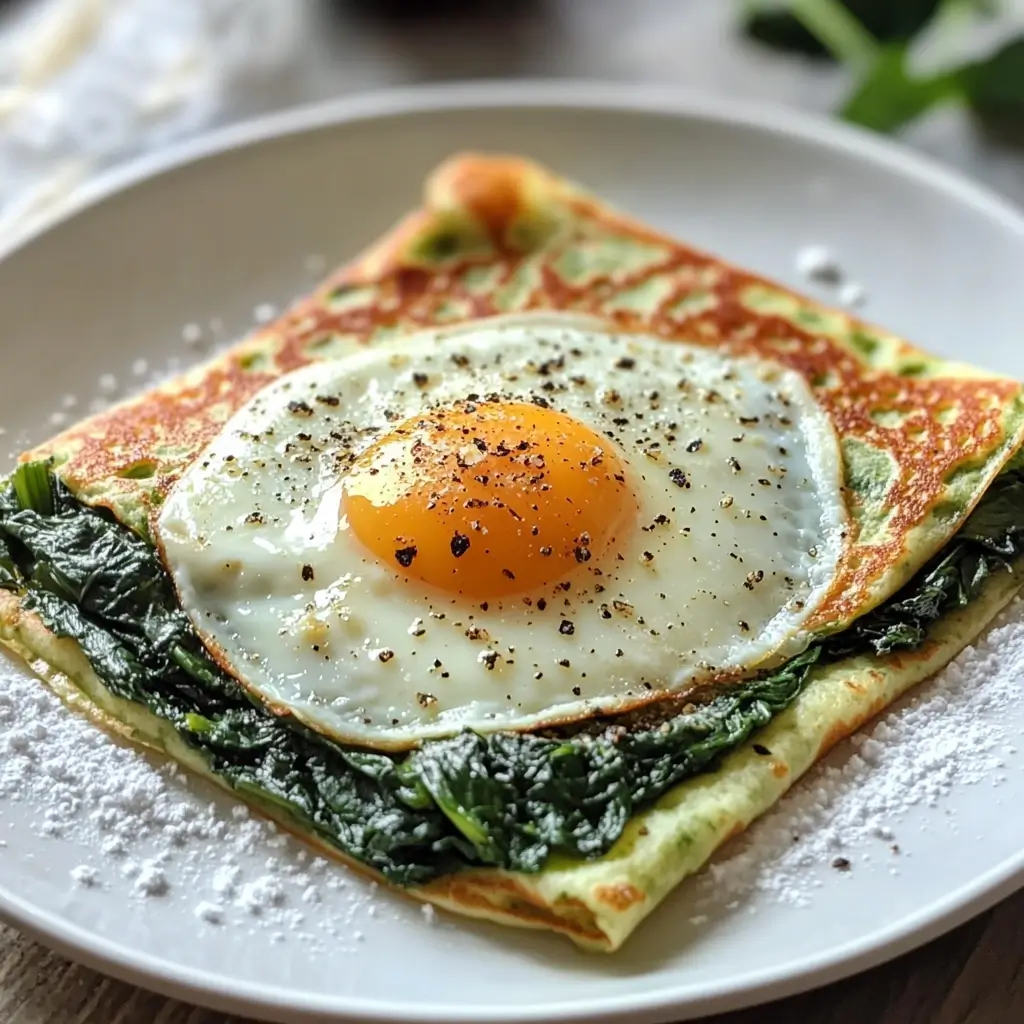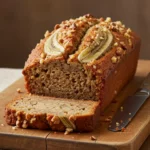There’s something undeniably comforting and elegant about crepes. They whisper of Parisian cafes and leisurely weekend brunches, yet they can often seem intimidating to make at home. For years, I shied away from attempting crepes, convinced they were too fussy for my everyday cooking. That was until I stumbled upon this recipe for Easy Baked Spinach and Egg Crepes. Let me tell you, this recipe is a game-changer. It’s not only surprisingly simple to execute, but it also delivers incredibly flavorful and satisfying results. My family absolutely adores these crepes. The delicate, slightly nutty crepes embrace a savory, creamy spinach and egg filling that’s both nutritious and utterly delicious. They are perfect for a special breakfast, a light lunch, or even a sophisticated brunch gathering. What I love most is that they are baked, which simplifies the process considerably and makes them ideal for preparing ahead of time. This recipe has become a staple in our home, and I’m thrilled to share it with you. Trust me, even if you’ve never made crepes before, you can master this recipe and impress yourself and your loved ones. Get ready to experience the joy of homemade crepes without the fuss!
Ingredients
This recipe utilizes simple, wholesome ingredients that you likely already have in your pantry and refrigerator. Let’s break down each component and understand its role in creating these delightful baked crepes.
For the Crepe Batter:
- 1 cup all-purpose flour or gluten-free flour: The foundation of our crepes! All-purpose flour provides the classic crepe texture, light and slightly chewy. For those seeking a gluten-free option, a good quality gluten-free all-purpose blend works wonderfully. When choosing gluten-free flour, ensure it’s a blend designed for baking, as single-ingredient flours like almond or coconut flour will require adjustments to the recipe due to their different binding properties. Using gluten-free flour can impart a slightly different texture, sometimes a bit more delicate or slightly grainier, but still delicious and crepe-like. Experiment with different brands to find your favorite gluten-free flour for crepes.
- 2 large eggs: Eggs are crucial for both structure and richness in the crepe batter. They bind the ingredients together, contributing to the crepe’s delicate yet resilient texture. Large eggs are standard in most recipes, ensuring the right liquid-to-solid ratio. If using medium eggs, you might consider adding a tablespoon or two more milk to achieve the desired batter consistency, which should be thin and pourable, like heavy cream. Eggs also add a subtle richness and flavor that complements both the savory filling and the delicate crepe itself.
- 1 1/2 cups milk (whole, low-fat, or plant-based): Milk provides the liquid component of the batter, creating the pourable consistency necessary for thin crepes. Whole milk will result in richer, slightly more tender crepes due to its higher fat content. Low-fat milk works just as well and offers a slightly lighter option without sacrificing too much flavor. For dairy-free alternatives, plant-based milks like almond milk, soy milk, oat milk, or even cashew milk are excellent substitutes. Each plant-based milk will impart a slightly different flavor profile; oat milk, for example, can add a subtle sweetness, while almond milk is quite neutral. Unsweetened varieties are recommended to keep the savory flavor profile of the dish in focus.
- 2 tablespoons melted butter, plus extra for greasing: Melted butter adds flavor, richness, and tenderness to the crepes. It also helps prevent the crepes from sticking to the pan. Unsalted butter is generally preferred in baking and cooking, allowing you to control the overall salt level. You can also use olive oil or another neutral-flavored oil for a dairy-free alternative in the batter, though butter will impart a more classic crepe flavor. For greasing the pan, butter is ideal for flavor and browning, but cooking spray or a neutral oil can also be used effectively.
- 1/4 teaspoon salt: Salt is a crucial ingredient in almost all recipes, even sweet ones! It enhances the flavors of the other ingredients and balances the overall taste. In crepes, a touch of salt prevents them from tasting bland and brings out the subtle sweetness of the milk and the richness of the eggs and butter. Don’t skip the salt; it makes a noticeable difference.
For the Spinach and Egg Filling:
- 1 tablespoon olive oil: Olive oil is used for sautéing the vegetables, adding flavor and preventing sticking. Extra virgin olive oil is a great choice for its flavor and health benefits, but regular olive oil or another cooking oil like avocado oil or canola oil can also be used.
- 1 small onion, finely chopped: Onion forms the aromatic base of the filling, adding depth and savory flavor. Yellow or white onions are suitable choices. Finely chopping the onion ensures it cooks evenly and melds seamlessly into the filling. Shallots can also be used for a milder, more delicate onion flavor.
- 2 garlic cloves, minced: Garlic is another flavor powerhouse, adding pungency and complexity to the filling. Freshly minced garlic is always best for flavor, but pre-minced garlic from a jar can be a convenient alternative. Adjust the amount of garlic to your preference; some may prefer more or less depending on their taste.
- 4 cups fresh spinach leaves: Spinach is the star vegetable in our filling, providing nutrients, color, and a mild, earthy flavor. Fresh spinach is recommended for this recipe, as frozen spinach, while usable, will require thawing and squeezing out excess moisture, and may have a slightly less vibrant texture. Baby spinach is particularly convenient as it is pre-washed and tender. Don’t be alarmed by the volume – spinach wilts down significantly when cooked.
- 4 large eggs: Eggs are the protein component of the filling, adding richness and substance. They are lightly scrambled and mixed with the spinach, creating a creamy and flavorful filling. Similar to the batter, large eggs are standard.
- 1/4 cup grated Parmesan cheese (optional): Parmesan cheese adds a salty, savory, and umami-rich dimension to the filling. It’s optional, but highly recommended for enhancing the flavor profile. Freshly grated Parmesan is always superior in flavor to pre-grated, which can sometimes be dry and less flavorful. Other hard cheeses like Pecorino Romano or Grana Padano can also be used. For a dairy-free option, nutritional yeast can provide a cheesy, savory flavor.
- Salt and pepper to taste: Seasoning is crucial to bring out the flavors of all the ingredients. Salt enhances the savory notes, and pepper adds a touch of spice and complexity. Taste the filling after cooking and adjust the seasoning to your liking. Freshly ground black pepper is always preferable for its flavor.
For Topping (Optional):
- 1/2 cup shredded mozzarella or Gruyere cheese: Shredded cheese, melted on top of the baked crepes, adds a beautiful golden crust, extra flavor, and a delightful gooey texture. Mozzarella provides a mild, melty flavor, while Gruyere offers a more complex, nutty, and slightly tangy taste. A combination of both cheeses would also be excellent. Other good cheese options include cheddar, provolone, or fontina.
- Fresh herbs (e.g., parsley or chives): Fresh herbs add a pop of color, freshness, and aromatic complexity to the finished dish. Parsley and chives are classic choices that complement the savory flavors of the crepes and filling. Other herbs like thyme, oregano, or dill could also be used, depending on your preference. Finely chopped herbs are best sprinkled over the crepes just before serving for maximum freshness and visual appeal.
Instructions
Let’s walk through each step of making these Easy Baked Spinach and Egg Crepes. Don’t worry, it’s easier than you might think!
Step 1: Prepare the Crepe Batter – The Foundation of Deliciousness
- Combine Wet Ingredients: In a large mixing bowl, start by whisking together the 2 large eggs and 1 1/2 cups of milk. Whisk vigorously until they are thoroughly combined and slightly frothy. This initial step ensures a smooth emulsion, which is key to a lump-free batter.
- Incorporate Dry Ingredients Gradually: Now, gradually add the 1 cup of all-purpose flour (or gluten-free flour blend) and 1/4 teaspoon of salt to the wet ingredients. It’s crucial to add the flour gradually, whisking continuously as you do so. This prevents lumps from forming. If you add all the flour at once, it can clump together and be difficult to incorporate smoothly. Continue whisking until the batter is smooth and free of any lumps. Don’t overmix, though; just whisk until everything is just combined. Overmixing can develop the gluten in the flour, leading to tougher crepes.
- Add Melted Butter: Gently mix in the 2 tablespoons of melted butter. Melt the butter in the microwave or in a small saucepan on the stovetop and let it cool slightly before adding it to the batter. Hot butter could cook the eggs slightly. Whisk until the melted butter is fully incorporated into the batter, creating a slightly richer and more flavorful base for your crepes.
- Rest the Batter (Crucial Step!): Let the batter rest for 10-15 minutes at room temperature. This resting period is essential. It allows the flour to fully hydrate, which results in a smoother batter and more tender crepes. Resting also allows any air bubbles created during whisking to dissipate, leading to thinner and more delicate crepes. While the batter rests, you can prepare the spinach and egg filling.
Step 2: Make the Spinach and Egg Filling – Savory and Nutritious
- Sauté Aromatics: Heat 1 tablespoon of olive oil in a skillet over medium heat. Once the oil is shimmering, add the 1 small finely chopped onion and 2 minced garlic cloves. Sauté the onion and garlic until they become translucent and fragrant, about 3-5 minutes. Stir occasionally to prevent burning. Sautéing these aromatics first builds a flavorful base for the filling.
- Wilt the Spinach: Add 4 cups of fresh spinach leaves to the skillet. Don’t worry about the large volume; spinach wilts down significantly as it cooks. Cook, stirring frequently, until the spinach is completely wilted and tender, which should take just a few minutes. Season with salt and pepper to taste at this stage. Taste and adjust seasoning as needed.
- Cool Slightly: Remove the skillet from the heat and let the spinach mixture cool slightly. This is important because you don’t want to cook the eggs prematurely when you add them.
- Scramble Eggs Lightly: In a separate bowl, beat the 4 large eggs lightly with a fork or whisk. You just want to break the yolks and combine the whites and yolks; don’t overbeat. In the same skillet you used for the spinach (no need to wash it), lightly scramble the beaten eggs over medium-low heat until they are just set but still slightly soft and creamy. You don’t want to overcook them, as they will continue to cook in the oven.
- Combine Filling Ingredients: Add the lightly scrambled eggs to the skillet with the wilted spinach mixture. If desired, stir in 1/4 cup of grated Parmesan cheese. Gently mix everything together until well combined. Taste the filling and adjust seasoning with salt and pepper as needed. Set the filling aside.
Step 3: Cook the Crepes – Thin and Delicate
- Heat and Grease Pan: Heat a non-stick skillet or crepe pan over medium heat. The pan should be nicely heated before you start cooking the crepes. Lightly grease the pan with a little butter. You can use a cooking brush or a paper towel to evenly distribute the butter. You only need a very thin layer of grease to prevent sticking.
- Pour and Spread Batter: Once the pan is hot, pour a small ladleful (about 1/4 cup) of crepe batter into the center of the hot pan. Immediately tilt and swirl the pan in a circular motion to spread the batter thinly and evenly across the bottom of the pan. The key to thin crepes is to use a small amount of batter and spread it quickly.
- Cook First Side: Cook the crepe for about 1-2 minutes on the first side, or until the edges start to look set and slightly golden brown and lift easily from the pan. You should see small bubbles forming on the surface of the crepe as it cooks.
- Flip and Cook Second Side: Carefully flip the crepe using a thin spatula. Cook for another 30 seconds to 1 minute on the second side, just until lightly cooked. The second side usually cooks faster than the first.
- Repeat: Remove the cooked crepe from the pan and set it aside on a plate. Repeat steps 2-4 with the remaining batter, greasing the pan lightly with butter between crepes as needed. You should get about 8-10 crepes from this recipe, depending on the size of your pan and how thinly you spread the batter. Stack the cooked crepes on a plate, separating them with parchment paper if you are not assembling them immediately to prevent sticking.
Step 4: Assemble and Bake – Final Touches and Warmth
- Preheat Oven: Preheat your oven to 375°F (190°C).
- Grease Baking Dish: Lightly grease a 9×13 inch baking dish (or similar size) with butter or cooking spray.
- Fill and Roll/Fold Crepes: Place a spoonful (about 2-3 tablespoons) of the spinach and egg filling onto the center of each crepe. Roll the crepe up tightly like a cylinder or fold it into a rectangular parcel, tucking in the sides. The folding method is a matter of personal preference and presentation.
- Arrange in Baking Dish: Arrange the filled crepes seam-side down in the prepared baking dish. Placing them seam-side down helps them stay closed during baking.
- Top with Cheese (Optional): If desired, sprinkle 1/2 cup of shredded mozzarella or Gruyere cheese (or a combination) evenly over the top of the crepes.
- Bake Covered: Cover the baking dish tightly with aluminum foil. Bake in the preheated oven for 15 minutes. Covering with foil helps to heat the crepes through and melt the cheese without over-browning the tops.
- Bake Uncovered: Remove the foil and bake for an additional 5 minutes, or until the cheese is bubbly, melted, and lightly golden brown and the crepes are heated through.
- Garnish and Serve: Remove the baked crepes from the oven. Garnish with fresh herbs, such as chopped parsley or chives, if desired. Serve immediately and enjoy!
Nutrition Facts
(Estimated, per serving, may vary based on specific ingredients and brands)
- Servings: 4
- Calories per serving: Approximately 350-450 calories
These are estimated values and can vary depending on the type of milk, cheese, and other ingredients used. For more precise nutritional information, you can use online nutritional calculators and input the specific brands and quantities of ingredients you use. Generally, these crepes are a good source of protein, vitamins (especially from spinach and eggs), and calcium.
Preparation Time
- Prep Time: 20 minutes
- Cook Time: 25 minutes
- Total Time: 45 minutes
This recipe is relatively quick to prepare, especially considering it includes making crepes from scratch. The active cooking time is around 25 minutes, and the total time from start to finish is less than an hour, making it a manageable dish for weeknight dinners or weekend brunches.
How to Serve
These Easy Baked Spinach and Egg Crepes are versatile and can be served in various ways for different occasions. Here are some serving suggestions:
- Breakfast/Brunch:
- Serve them warm straight from the oven as a satisfying and elegant breakfast or brunch dish.
- Pair them with a side of fresh fruit salad or berries for a balanced and refreshing meal.
- Offer a dollop of plain yogurt or sour cream on top for added creaminess and tang.
- Lunch/Light Dinner:
- Serve them as a light yet filling lunch or dinner option.
- Accompany them with a simple green salad dressed with a light vinaigrette to create a complete and nutritious meal.
- For a heartier meal, serve them with a side of roasted vegetables like asparagus or broccoli.
- Appetizer/Starter:
- Cut the baked crepes into smaller portions and serve them as an appetizer or starter for a dinner party.
- Garnish them with a sprinkle of fresh herbs and a drizzle of balsamic glaze for an elegant presentation.
- Sauce Options (Optional):
- While these crepes are delicious on their own, you can enhance them further with a light sauce.
- A simple béchamel sauce or a creamy mushroom sauce would complement the savory filling beautifully.
- For a lighter option, consider a lemon-butter sauce or a hollandaise sauce (served on the side).
Additional Tips for Crepe Success
- Batter Consistency is Key: The crepe batter should be thin, like heavy cream. If it seems too thick, add a tablespoon or two more milk until you reach the desired consistency. A thin batter is essential for making delicate crepes.
- Hot Pan is Crucial: Ensure your skillet or crepe pan is properly heated before pouring in the batter. A hot pan will allow the crepes to cook quickly and evenly, preventing them from sticking and ensuring they have a slightly crispy edge.
- Don’t Overfill Crepes: When filling the crepes, avoid overfilling them. Too much filling can make them difficult to roll or fold and may cause them to burst during baking. Use a moderate amount of filling for each crepe.
- Make Crepes Ahead of Time: You can make the crepes ahead of time and store them in the refrigerator, stacked and wrapped in plastic wrap, for up to 2 days. Reheat them gently before filling and baking. This is a great time-saving tip for busy schedules.
- Experiment with Fillings: While spinach and egg is a classic and delicious filling, feel free to experiment with other savory fillings. Consider adding sautéed mushrooms, cooked chicken or ham, roasted vegetables, or different types of cheese to create your own signature baked crepes.
Frequently Asked Questions (FAQ)
Q1: Can I make the crepe batter ahead of time?
A: Yes, you can! In fact, making the batter ahead of time can actually improve the texture of the crepes. You can prepare the batter up to 24 hours in advance and store it in the refrigerator. Just be sure to whisk it again briefly before using, as it may thicken slightly upon standing.
Q2: Can I freeze the cooked crepes?
A: Yes, you can freeze cooked crepes, both filled and unfilled. To freeze unfilled crepes, stack them with parchment paper in between to prevent sticking, wrap them tightly in plastic wrap and then in a freezer bag. To freeze filled and baked crepes, allow them to cool completely, then wrap individually or in portions and freeze. Thaw them in the refrigerator overnight and reheat in the oven or microwave.
Q3: I don’t have a crepe pan. Can I use a regular skillet?
A: Absolutely! While a crepe pan is ideal for its shallow sides and even heat distribution, you can definitely use a regular non-stick skillet. Choose a skillet with a flat bottom and ensure it’s well-seasoned or non-stick to prevent the crepes from sticking.
Q4: Can I make these crepes dairy-free?
A: Yes, you can easily make these crepes dairy-free. Use a plant-based milk like almond milk, soy milk, or oat milk for the batter. Substitute the melted butter in the batter with olive oil or another neutral-flavored oil. For the filling and topping, omit the Parmesan and mozzarella cheese or use dairy-free cheese alternatives.
Q5: My crepes are tearing when I try to flip them. What am I doing wrong?
A: Tearing crepes usually indicates that they are not cooked enough on the first side or that the pan is not properly greased. Make sure you are cooking the crepes for at least 1-2 minutes on the first side until the edges are set and they lift easily. Also, ensure your pan is well-greased before cooking each crepe. Using a thin, flexible spatula can also help with flipping delicate crepes.

Easiest Baked Spinach and Egg Crepes Recipe
Ingredients
For the Crepe Batter:
- 1 cup all-purpose flour or gluten-free flour: The foundation of our crepes! All-purpose flour provides the classic crepe texture, light and slightly chewy. For those seeking a gluten-free option, a good quality gluten-free all-purpose blend works wonderfully. When choosing gluten-free flour, ensure it’s a blend designed for baking, as single-ingredient flours like almond or coconut flour will require adjustments to the recipe due to their different binding properties. Using gluten-free flour can impart a slightly different texture, sometimes a bit more delicate or slightly grainier, but still delicious and crepe-like. Experiment with different brands to find your favorite gluten-free flour for crepes.
- 2 large eggs: Eggs are crucial for both structure and richness in the crepe batter. They bind the ingredients together, contributing to the crepe’s delicate yet resilient texture. Large eggs are standard in most recipes, ensuring the right liquid-to-solid ratio. If using medium eggs, you might consider adding a tablespoon or two more milk to achieve the desired batter consistency, which should be thin and pourable, like heavy cream. Eggs also add a subtle richness and flavor that complements both the savory filling and the delicate crepe itself.
- 1 1/2 cups milk (whole, low-fat, or plant-based): Milk provides the liquid component of the batter, creating the pourable consistency necessary for thin crepes. Whole milk will result in richer, slightly more tender crepes due to its higher fat content. Low-fat milk works just as well and offers a slightly lighter option without sacrificing too much flavor. For dairy-free alternatives, plant-based milks like almond milk, soy milk, oat milk, or even cashew milk are excellent substitutes. Each plant-based milk will impart a slightly different flavor profile; oat milk, for example, can add a subtle sweetness, while almond milk is quite neutral. Unsweetened varieties are recommended to keep the savory flavor profile of the dish in focus.
- 2 tablespoons melted butter, plus extra for greasing: Melted butter adds flavor, richness, and tenderness to the crepes. It also helps prevent the crepes from sticking to the pan. Unsalted butter is generally preferred in baking and cooking, allowing you to control the overall salt level. You can also use olive oil or another neutral-flavored oil for a dairy-free alternative in the batter, though butter will impart a more classic crepe flavor. For greasing the pan, butter is ideal for flavor and browning, but cooking spray or a neutral oil can also be used effectively.
- 1/4 teaspoon salt: Salt is a crucial ingredient in almost all recipes, even sweet ones! It enhances the flavors of the other ingredients and balances the overall taste. In crepes, a touch of salt prevents them from tasting bland and brings out the subtle sweetness of the milk and the richness of the eggs and butter. Don’t skip the salt; it makes a noticeable difference.
For the Spinach and Egg Filling:
- 1 tablespoon olive oil: Olive oil is used for sautéing the vegetables, adding flavor and preventing sticking. Extra virgin olive oil is a great choice for its flavor and health benefits, but regular olive oil or another cooking oil like avocado oil or canola oil can also be used.
- 1 small onion, finely chopped: Onion forms the aromatic base of the filling, adding depth and savory flavor. Yellow or white onions are suitable choices. Finely chopping the onion ensures it cooks evenly and melds seamlessly into the filling. Shallots can also be used for a milder, more delicate onion flavor.
- 2 garlic cloves, minced: Garlic is another flavor powerhouse, adding pungency and complexity to the filling. Freshly minced garlic is always best for flavor, but pre-minced garlic from a jar can be a convenient alternative. Adjust the amount of garlic to your preference; some may prefer more or less depending on their taste.
- 4 cups fresh spinach leaves: Spinach is the star vegetable in our filling, providing nutrients, color, and a mild, earthy flavor. Fresh spinach is recommended for this recipe, as frozen spinach, while usable, will require thawing and squeezing out excess moisture, and may have a slightly less vibrant texture. Baby spinach is particularly convenient as it is pre-washed and tender. Don’t be alarmed by the volume – spinach wilts down significantly when cooked.
- 4 large eggs: Eggs are the protein component of the filling, adding richness and substance. They are lightly scrambled and mixed with the spinach, creating a creamy and flavorful filling. Similar to the batter, large eggs are standard.
- 1/4 cup grated Parmesan cheese (optional): Parmesan cheese adds a salty, savory, and umami-rich dimension to the filling. It’s optional, but highly recommended for enhancing the flavor profile. Freshly grated Parmesan is always superior in flavor to pre-grated, which can sometimes be dry and less flavorful. Other hard cheeses like Pecorino Romano or Grana Padano can also be used. For a dairy-free option, nutritional yeast can provide a cheesy, savory flavor.
- Salt and pepper to taste: Seasoning is crucial to bring out the flavors of all the ingredients. Salt enhances the savory notes, and pepper adds a touch of spice and complexity. Taste the filling after cooking and adjust the seasoning to your liking. Freshly ground black pepper is always preferable for its flavor.
For Topping (Optional):
- 1/2 cup shredded mozzarella or Gruyere cheese: Shredded cheese, melted on top of the baked crepes, adds a beautiful golden crust, extra flavor, and a delightful gooey texture. Mozzarella provides a mild, melty flavor, while Gruyere offers a more complex, nutty, and slightly tangy taste. A combination of both cheeses would also be excellent. Other good cheese options include cheddar, provolone, or fontina.
- Fresh herbs (e.g., parsley or chives): Fresh herbs add a pop of color, freshness, and aromatic complexity to the finished dish. Parsley and chives are classic choices that complement the savory flavors of the crepes and filling. Other herbs like thyme, oregano, or dill could also be used, depending on your preference. Finely chopped herbs are best sprinkled over the crepes just before serving for maximum freshness and visual appeal.
Instructions
Step 1: Prepare the Crepe Batter – The Foundation of Deliciousness
- Combine Wet Ingredients: In a large mixing bowl, start by whisking together the 2 large eggs and 1 1/2 cups of milk. Whisk vigorously until they are thoroughly combined and slightly frothy. This initial step ensures a smooth emulsion, which is key to a lump-free batter.
- Incorporate Dry Ingredients Gradually: Now, gradually add the 1 cup of all-purpose flour (or gluten-free flour blend) and 1/4 teaspoon of salt to the wet ingredients. It’s crucial to add the flour gradually, whisking continuously as you do so. This prevents lumps from forming. If you add all the flour at once, it can clump together and be difficult to incorporate smoothly. Continue whisking until the batter is smooth and free of any lumps. Don’t overmix, though; just whisk until everything is just combined. Overmixing can develop the gluten in the flour, leading to tougher crepes.
- Add Melted Butter: Gently mix in the 2 tablespoons of melted butter. Melt the butter in the microwave or in a small saucepan on the stovetop and let it cool slightly before adding it to the batter. Hot butter could cook the eggs slightly. Whisk until the melted butter is fully incorporated into the batter, creating a slightly richer and more flavorful base for your crepes.
- Rest the Batter (Crucial Step!): Let the batter rest for 10-15 minutes at room temperature. This resting period is essential. It allows the flour to fully hydrate, which results in a smoother batter and more tender crepes. Resting also allows any air bubbles created during whisking to dissipate, leading to thinner and more delicate crepes. While the batter rests, you can prepare the spinach and egg filling.
Step 2: Make the Spinach and Egg Filling – Savory and Nutritious
- Sauté Aromatics: Heat 1 tablespoon of olive oil in a skillet over medium heat. Once the oil is shimmering, add the 1 small finely chopped onion and 2 minced garlic cloves. Sauté the onion and garlic until they become translucent and fragrant, about 3-5 minutes. Stir occasionally to prevent burning. Sautéing these aromatics first builds a flavorful base for the filling.
- Wilt the Spinach: Add 4 cups of fresh spinach leaves to the skillet. Don’t worry about the large volume; spinach wilts down significantly as it cooks. Cook, stirring frequently, until the spinach is completely wilted and tender, which should take just a few minutes. Season with salt and pepper to taste at this stage. Taste and adjust seasoning as needed.
- Cool Slightly: Remove the skillet from the heat and let the spinach mixture cool slightly. This is important because you don’t want to cook the eggs prematurely when you add them.
- Scramble Eggs Lightly: In a separate bowl, beat the 4 large eggs lightly with a fork or whisk. You just want to break the yolks and combine the whites and yolks; don’t overbeat. In the same skillet you used for the spinach (no need to wash it), lightly scramble the beaten eggs over medium-low heat until they are just set but still slightly soft and creamy. You don’t want to overcook them, as they will continue to cook in the oven.
- Combine Filling Ingredients: Add the lightly scrambled eggs to the skillet with the wilted spinach mixture. If desired, stir in 1/4 cup of grated Parmesan cheese. Gently mix everything together until well combined. Taste the filling and adjust seasoning with salt and pepper as needed. Set the filling aside.
Step 3: Cook the Crepes – Thin and Delicate
- Heat and Grease Pan: Heat a non-stick skillet or crepe pan over medium heat. The pan should be nicely heated before you start cooking the crepes. Lightly grease the pan with a little butter. You can use a cooking brush or a paper towel to evenly distribute the butter. You only need a very thin layer of grease to prevent sticking.
- Pour and Spread Batter: Once the pan is hot, pour a small ladleful (about 1/4 cup) of crepe batter into the center of the hot pan. Immediately tilt and swirl the pan in a circular motion to spread the batter thinly and evenly across the bottom of the pan. The key to thin crepes is to use a small amount of batter and spread it quickly.
- Cook First Side: Cook the crepe for about 1-2 minutes on the first side, or until the edges start to look set and slightly golden brown and lift easily from the pan. You should see small bubbles forming on the surface of the crepe as it cooks.
- Flip and Cook Second Side: Carefully flip the crepe using a thin spatula. Cook for another 30 seconds to 1 minute on the second side, just until lightly cooked. The second side usually cooks faster than the first.
- Repeat: Remove the cooked crepe from the pan and set it aside on a plate. Repeat steps 2-4 with the remaining batter, greasing the pan lightly with butter between crepes as needed. You should get about 8-10 crepes from this recipe, depending on the size of your pan and how thinly you spread the batter. Stack the cooked crepes on a plate, separating them with parchment paper if you are not assembling them immediately to prevent sticking.
Step 4: Assemble and Bake – Final Touches and Warmth
- Preheat Oven: Preheat your oven to 375°F (190°C).
- Grease Baking Dish: Lightly grease a 9×13 inch baking dish (or similar size) with butter or cooking spray.
- Fill and Roll/Fold Crepes: Place a spoonful (about 2-3 tablespoons) of the spinach and egg filling onto the center of each crepe. Roll the crepe up tightly like a cylinder or fold it into a rectangular parcel, tucking in the sides. The folding method is a matter of personal preference and presentation.
- Arrange in Baking Dish: Arrange the filled crepes seam-side down in the prepared baking dish. Placing them seam-side down helps them stay closed during baking.
- Top with Cheese (Optional): If desired, sprinkle 1/2 cup of shredded mozzarella or Gruyere cheese (or a combination) evenly over the top of the crepes.
- Bake Covered: Cover the baking dish tightly with aluminum foil. Bake in the preheated oven for 15 minutes. Covering with foil helps to heat the crepes through and melt the cheese without over-browning the tops.
- Bake Uncovered: Remove the foil and bake for an additional 5 minutes, or until the cheese is bubbly, melted, and lightly golden brown and the crepes are heated through.
- Garnish and Serve: Remove the baked crepes from the oven. Garnish with fresh herbs, such as chopped parsley or chives, if desired. Serve immediately and enjoy!
Nutrition
- Serving Size: one normal portion
- Calories: 350-450





